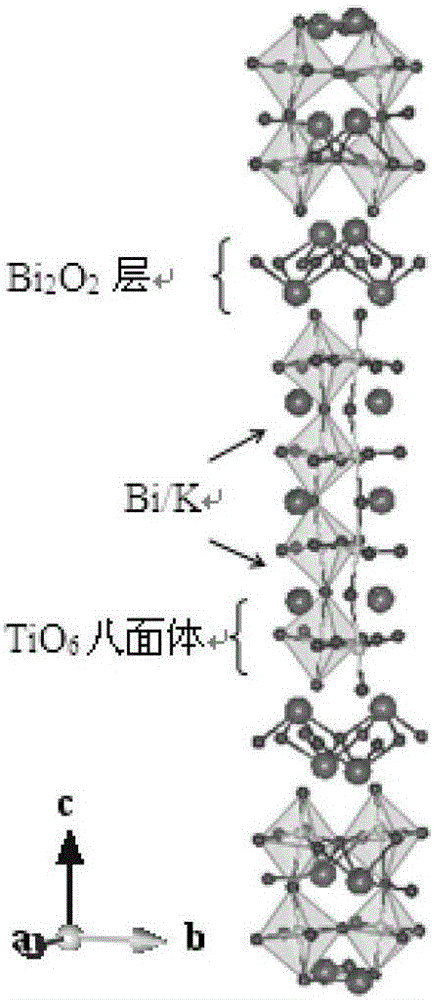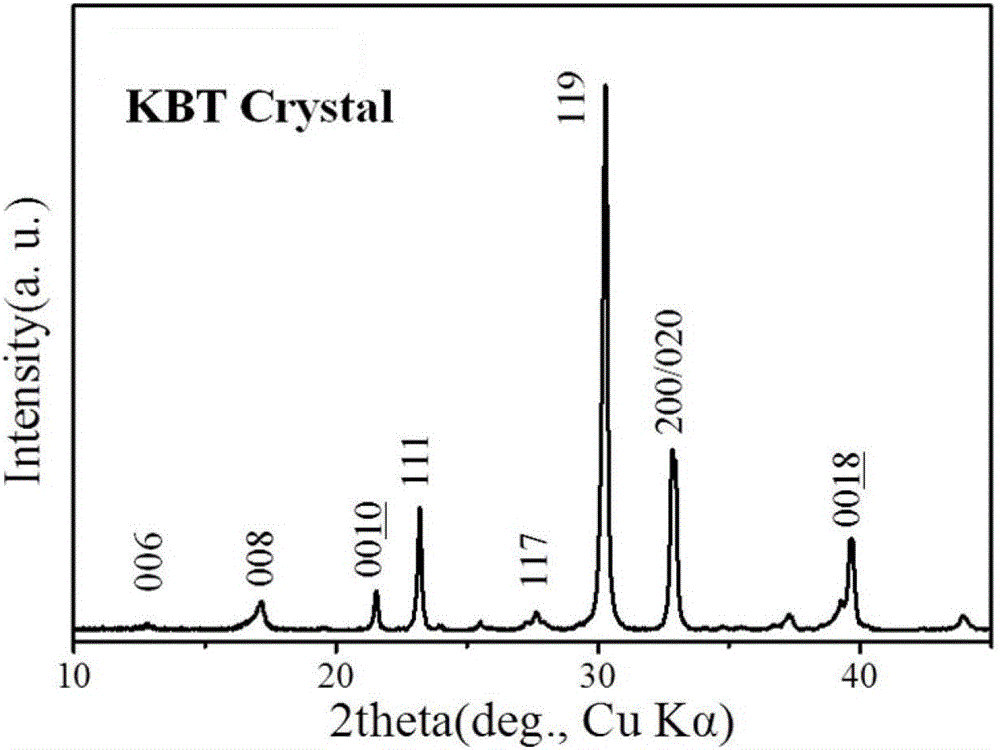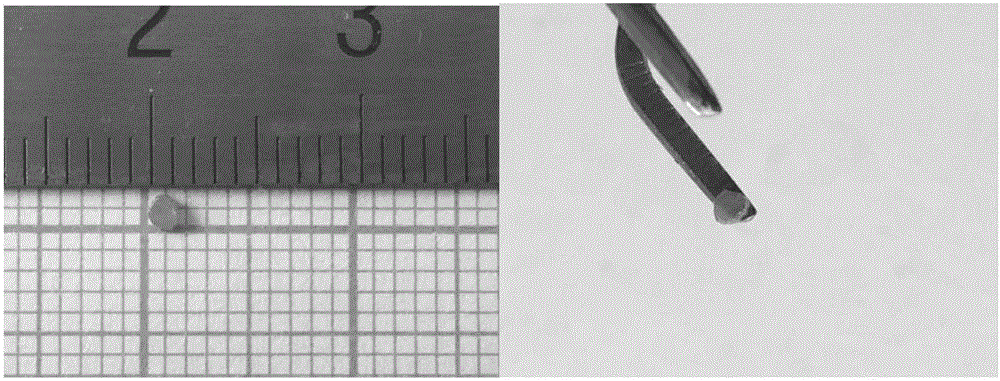Preparing technology of bismuth-layer-structure K0.5Bi4.5Ti4O15 crystal
A preparation process, bismuth layered technology, applied in the field of ferroelectric functional crystal materials, can solve problems such as domain inversion difficulties, and achieve the effects of easy control of uniformity, reduced defect concentration and impurity concentration, and short growth cycle
- Summary
- Abstract
- Description
- Claims
- Application Information
AI Technical Summary
Problems solved by technology
Method used
Image
Examples
Embodiment 1
[0025] A bismuth layered structure K 0.5 Bi 4.5 Ti 4 o 15 Crystal preparation process, concrete steps are as follows:
[0026] (1) will Bi 2 o 3 、K 2 CO 3 、TiO 2 Weigh the ingredients according to the molar ratio of 1:1:4, Bi 2 o 3 and K 2 CO 3 Excessive 5% to compensate for the loss of Bi and K elements during the thermal evaporation process. Mix the raw materials evenly and compact them into solid blocks, heat them in a muffle furnace to 750°C for 10 hours, and take out the polycrystalline material for grinding after the furnace cools down. Form into powder and compact it for secondary sintering. The secondary sintering temperature is 910°C for 2 hours. After the furnace body cools down, take it out to obtain polycrystalline material;
[0027] (2) Cut and polish the polycrystalline material to obtain a polycrystalline raw material rod, place the polycrystalline raw material rod in the lower part of the hollow platinum tube, the tube wall is in good contact with the...
Embodiment 2
[0031] A bismuth layered structure K 0.5 Bi 4.5 Ti 4 o 15 Crystal preparation process, concrete steps are as follows:
[0032] (1) will Bi 2 o 3 、K 2 CO 3 、TiO 2 Weigh the ingredients according to the molar ratio of 1:1:4, Bi 2 o 3 and K 2 CO 3 Excessive 5% to compensate for the loss of Bi and K elements during the thermal evaporation process. Mix the raw materials evenly and compact them into solid blocks, heat them in a muffle furnace to 750°C for 10 hours, and take out the polycrystalline material for grinding after the furnace cools down. It is powdered, compacted, and subjected to secondary sintering. The secondary sintering temperature is 910° C., and the sintering time is 2 hours. After the furnace cools down, the polycrystalline material is taken out.
[0033] (2) Cut and polish the polycrystalline material to obtain a polycrystalline raw material rod, place the polycrystalline raw material rod in the lower part of the hollow platinum tube, the tube wall is...
Embodiment 3
[0036] With the K that embodiment 1~2 makes 0.5 Bi 4.5 Ti 4 o 15 The crystal was used as the target material, and the pulsed laser deposition method was used to deposit K 0.5 Bi 4.5 Ti 4 o 15 Thin film, the selected substrate is Pt / Ti / SiO 2 / Si, the atmosphere is oxygen, the oxygen partial pressure is 120mTorr, the heating temperature is 550°C, and the deposition time is 40-60min.
[0037] Such as Figure 5 , is the ferroelectric domain structure of the thin film prepared in Example 3, where the figure (a) is K 0.5 Bi 4.5 Ti 4 o 15 The PFM morphology of the crystal, Figure (b) shows the corresponding micro-region under the condition of -12V electric field, and the obvious domain wall structure can be observed, Figure (c) shows the light and dark contrast of the domain wall under the condition of +12V voltage, which is Due to the polarization reversal of the domain wall under the action of an electric field, Figure (d) shows the polarization reversal phenomenon afte...
PUM
 Login to View More
Login to View More Abstract
Description
Claims
Application Information
 Login to View More
Login to View More - R&D
- Intellectual Property
- Life Sciences
- Materials
- Tech Scout
- Unparalleled Data Quality
- Higher Quality Content
- 60% Fewer Hallucinations
Browse by: Latest US Patents, China's latest patents, Technical Efficacy Thesaurus, Application Domain, Technology Topic, Popular Technical Reports.
© 2025 PatSnap. All rights reserved.Legal|Privacy policy|Modern Slavery Act Transparency Statement|Sitemap|About US| Contact US: help@patsnap.com



